Input interpretation

I_2 iodine + NH_2NH_2 diazane ⟶ N_2 nitrogen + HI hydrogen iodide
Balanced equation
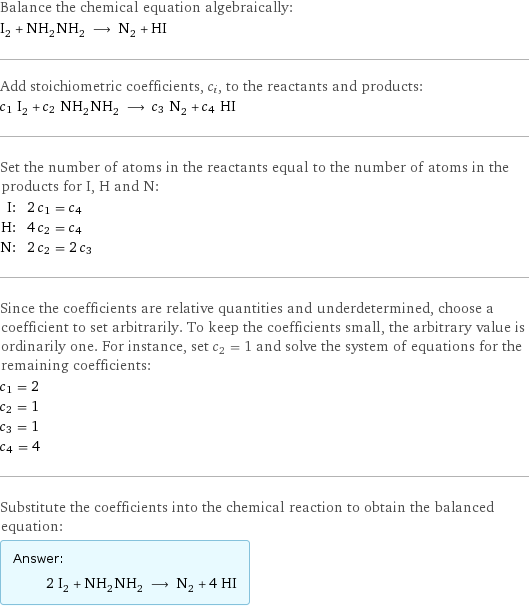
Balance the chemical equation algebraically: I_2 + NH_2NH_2 ⟶ N_2 + HI Add stoichiometric coefficients, c_i, to the reactants and products: c_1 I_2 + c_2 NH_2NH_2 ⟶ c_3 N_2 + c_4 HI Set the number of atoms in the reactants equal to the number of atoms in the products for I, H and N: I: | 2 c_1 = c_4 H: | 4 c_2 = c_4 N: | 2 c_2 = 2 c_3 Since the coefficients are relative quantities and underdetermined, choose a coefficient to set arbitrarily. To keep the coefficients small, the arbitrary value is ordinarily one. For instance, set c_2 = 1 and solve the system of equations for the remaining coefficients: c_1 = 2 c_2 = 1 c_3 = 1 c_4 = 4 Substitute the coefficients into the chemical reaction to obtain the balanced equation: Answer: | | 2 I_2 + NH_2NH_2 ⟶ N_2 + 4 HI
Structures

+ ⟶ +
Names

iodine + diazane ⟶ nitrogen + hydrogen iodide
Reaction thermodynamics
Enthalpy
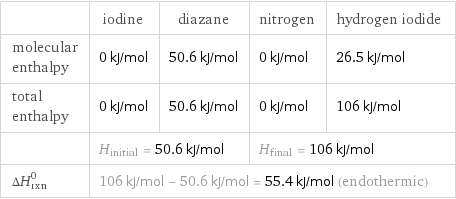
| iodine | diazane | nitrogen | hydrogen iodide molecular enthalpy | 0 kJ/mol | 50.6 kJ/mol | 0 kJ/mol | 26.5 kJ/mol total enthalpy | 0 kJ/mol | 50.6 kJ/mol | 0 kJ/mol | 106 kJ/mol | H_initial = 50.6 kJ/mol | | H_final = 106 kJ/mol | ΔH_rxn^0 | 106 kJ/mol - 50.6 kJ/mol = 55.4 kJ/mol (endothermic) | | |
Gibbs free energy
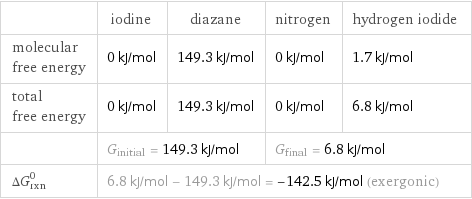
| iodine | diazane | nitrogen | hydrogen iodide molecular free energy | 0 kJ/mol | 149.3 kJ/mol | 0 kJ/mol | 1.7 kJ/mol total free energy | 0 kJ/mol | 149.3 kJ/mol | 0 kJ/mol | 6.8 kJ/mol | G_initial = 149.3 kJ/mol | | G_final = 6.8 kJ/mol | ΔG_rxn^0 | 6.8 kJ/mol - 149.3 kJ/mol = -142.5 kJ/mol (exergonic) | | |
Equilibrium constant
![Construct the equilibrium constant, K, expression for: I_2 + NH_2NH_2 ⟶ N_2 + HI Plan: • Balance the chemical equation. • Determine the stoichiometric numbers. • Assemble the activity expression for each chemical species. • Use the activity expressions to build the equilibrium constant expression. Write the balanced chemical equation: 2 I_2 + NH_2NH_2 ⟶ N_2 + 4 HI Assign stoichiometric numbers, ν_i, using the stoichiometric coefficients, c_i, from the balanced chemical equation in the following manner: ν_i = -c_i for reactants and ν_i = c_i for products: chemical species | c_i | ν_i I_2 | 2 | -2 NH_2NH_2 | 1 | -1 N_2 | 1 | 1 HI | 4 | 4 Assemble the activity expressions accounting for the state of matter and ν_i: chemical species | c_i | ν_i | activity expression I_2 | 2 | -2 | ([I2])^(-2) NH_2NH_2 | 1 | -1 | ([NH2NH2])^(-1) N_2 | 1 | 1 | [N2] HI | 4 | 4 | ([HI])^4 The equilibrium constant symbol in the concentration basis is: K_c Mulitply the activity expressions to arrive at the K_c expression: Answer: | | K_c = ([I2])^(-2) ([NH2NH2])^(-1) [N2] ([HI])^4 = ([N2] ([HI])^4)/(([I2])^2 [NH2NH2])](../image_source/d3cb7577bdd3b72500e16a3075129a49.png)
Construct the equilibrium constant, K, expression for: I_2 + NH_2NH_2 ⟶ N_2 + HI Plan: • Balance the chemical equation. • Determine the stoichiometric numbers. • Assemble the activity expression for each chemical species. • Use the activity expressions to build the equilibrium constant expression. Write the balanced chemical equation: 2 I_2 + NH_2NH_2 ⟶ N_2 + 4 HI Assign stoichiometric numbers, ν_i, using the stoichiometric coefficients, c_i, from the balanced chemical equation in the following manner: ν_i = -c_i for reactants and ν_i = c_i for products: chemical species | c_i | ν_i I_2 | 2 | -2 NH_2NH_2 | 1 | -1 N_2 | 1 | 1 HI | 4 | 4 Assemble the activity expressions accounting for the state of matter and ν_i: chemical species | c_i | ν_i | activity expression I_2 | 2 | -2 | ([I2])^(-2) NH_2NH_2 | 1 | -1 | ([NH2NH2])^(-1) N_2 | 1 | 1 | [N2] HI | 4 | 4 | ([HI])^4 The equilibrium constant symbol in the concentration basis is: K_c Mulitply the activity expressions to arrive at the K_c expression: Answer: | | K_c = ([I2])^(-2) ([NH2NH2])^(-1) [N2] ([HI])^4 = ([N2] ([HI])^4)/(([I2])^2 [NH2NH2])
Rate of reaction
![Construct the rate of reaction expression for: I_2 + NH_2NH_2 ⟶ N_2 + HI Plan: • Balance the chemical equation. • Determine the stoichiometric numbers. • Assemble the rate term for each chemical species. • Write the rate of reaction expression. Write the balanced chemical equation: 2 I_2 + NH_2NH_2 ⟶ N_2 + 4 HI Assign stoichiometric numbers, ν_i, using the stoichiometric coefficients, c_i, from the balanced chemical equation in the following manner: ν_i = -c_i for reactants and ν_i = c_i for products: chemical species | c_i | ν_i I_2 | 2 | -2 NH_2NH_2 | 1 | -1 N_2 | 1 | 1 HI | 4 | 4 The rate term for each chemical species, B_i, is 1/ν_i(Δ[B_i])/(Δt) where [B_i] is the amount concentration and t is time: chemical species | c_i | ν_i | rate term I_2 | 2 | -2 | -1/2 (Δ[I2])/(Δt) NH_2NH_2 | 1 | -1 | -(Δ[NH2NH2])/(Δt) N_2 | 1 | 1 | (Δ[N2])/(Δt) HI | 4 | 4 | 1/4 (Δ[HI])/(Δt) (for infinitesimal rate of change, replace Δ with d) Set the rate terms equal to each other to arrive at the rate expression: Answer: | | rate = -1/2 (Δ[I2])/(Δt) = -(Δ[NH2NH2])/(Δt) = (Δ[N2])/(Δt) = 1/4 (Δ[HI])/(Δt) (assuming constant volume and no accumulation of intermediates or side products)](../image_source/39e41d4fbaf7108dadb540c67fd8de4d.png)
Construct the rate of reaction expression for: I_2 + NH_2NH_2 ⟶ N_2 + HI Plan: • Balance the chemical equation. • Determine the stoichiometric numbers. • Assemble the rate term for each chemical species. • Write the rate of reaction expression. Write the balanced chemical equation: 2 I_2 + NH_2NH_2 ⟶ N_2 + 4 HI Assign stoichiometric numbers, ν_i, using the stoichiometric coefficients, c_i, from the balanced chemical equation in the following manner: ν_i = -c_i for reactants and ν_i = c_i for products: chemical species | c_i | ν_i I_2 | 2 | -2 NH_2NH_2 | 1 | -1 N_2 | 1 | 1 HI | 4 | 4 The rate term for each chemical species, B_i, is 1/ν_i(Δ[B_i])/(Δt) where [B_i] is the amount concentration and t is time: chemical species | c_i | ν_i | rate term I_2 | 2 | -2 | -1/2 (Δ[I2])/(Δt) NH_2NH_2 | 1 | -1 | -(Δ[NH2NH2])/(Δt) N_2 | 1 | 1 | (Δ[N2])/(Δt) HI | 4 | 4 | 1/4 (Δ[HI])/(Δt) (for infinitesimal rate of change, replace Δ with d) Set the rate terms equal to each other to arrive at the rate expression: Answer: | | rate = -1/2 (Δ[I2])/(Δt) = -(Δ[NH2NH2])/(Δt) = (Δ[N2])/(Δt) = 1/4 (Δ[HI])/(Δt) (assuming constant volume and no accumulation of intermediates or side products)
Chemical names and formulas
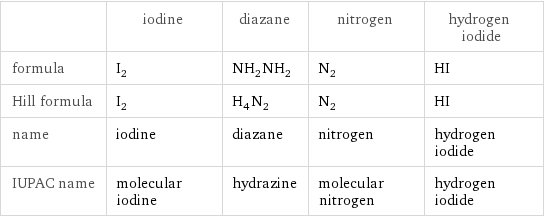
| iodine | diazane | nitrogen | hydrogen iodide formula | I_2 | NH_2NH_2 | N_2 | HI Hill formula | I_2 | H_4N_2 | N_2 | HI name | iodine | diazane | nitrogen | hydrogen iodide IUPAC name | molecular iodine | hydrazine | molecular nitrogen | hydrogen iodide
Substance properties
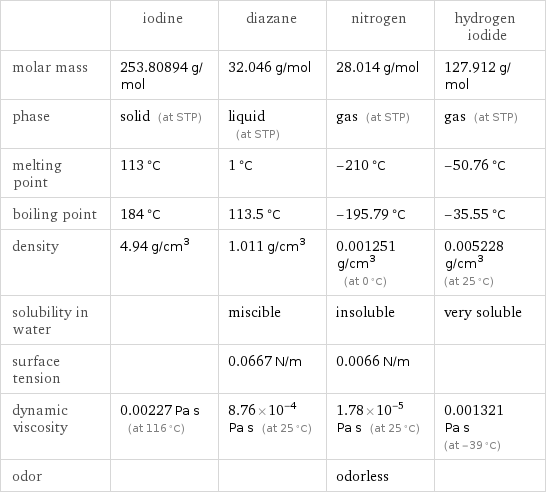
| iodine | diazane | nitrogen | hydrogen iodide molar mass | 253.80894 g/mol | 32.046 g/mol | 28.014 g/mol | 127.912 g/mol phase | solid (at STP) | liquid (at STP) | gas (at STP) | gas (at STP) melting point | 113 °C | 1 °C | -210 °C | -50.76 °C boiling point | 184 °C | 113.5 °C | -195.79 °C | -35.55 °C density | 4.94 g/cm^3 | 1.011 g/cm^3 | 0.001251 g/cm^3 (at 0 °C) | 0.005228 g/cm^3 (at 25 °C) solubility in water | | miscible | insoluble | very soluble surface tension | | 0.0667 N/m | 0.0066 N/m | dynamic viscosity | 0.00227 Pa s (at 116 °C) | 8.76×10^-4 Pa s (at 25 °C) | 1.78×10^-5 Pa s (at 25 °C) | 0.001321 Pa s (at -39 °C) odor | | | odorless |
Units
